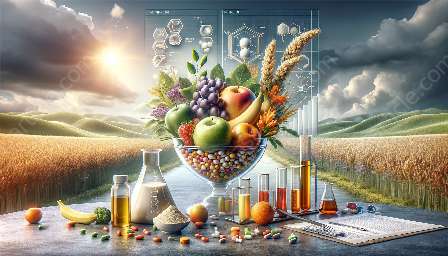Food chains and nutrient flows are essential concepts in nutritional ecology and nutrition science, providing crucial insights into the intricate relationships and flows of energy and nutrients in ecosystems.
The Basics of Food Chains
At its core, a food chain represents the flow of energy and nutrients through an ecosystem. It illustrates the transfer of energy and nutrients from one organism to another. In a typical food chain, energy flows from one trophic level to another, starting with producers, such as plants, and ending with top predators.
Primary Producers (Autotrophs)
Primary producers, or autotrophs, are the foundation of every food chain. These organisms, typically plants, algae, and some bacteria, are capable of photosynthesis, converting sunlight, water, and carbon dioxide into organic compounds. Through this process, they produce the energy and nutrients that sustain all other organisms in the ecosystem.
Primary Consumers (Herbivores)
Next in the food chain are the primary consumers, also known as herbivores. These organisms feed directly on the primary producers, obtaining energy and nutrients from plant matter.
Secondary Consumers (Carnivores and Omnivores)
Following the primary consumers, secondary consumers are carnivores and omnivores that feed on herbivores. They derive their energy and nutrients from consuming other animals.
Tertiary Consumers (Top Predators)
At the top of the food chain are the tertiary consumers, also known as top predators. These organisms occupy the highest trophic level and consume other carnivores, establishing a crucial balance in the ecosystem.
Nutrient Flows in Food Chains
Alongside the flow of energy, nutrient flows play a vital role in sustaining the balance and functionality of food chains and ecosystems. Nutrient cycling, or biogeochemical cycles, involves the movement and exchange of essential nutrients throughout an ecosystem. The key nutrients involved in these cycles include carbon, nitrogen, phosphorus, and other elements crucial for life.
Carbon Cycle
The carbon cycle illustrates the circulation of carbon through the biosphere, including the movement of carbon between the atmosphere, living organisms, soil, and oceans. This cycle plays a critical role in the regulation of climate and the provision of essential carbon-based compounds for all living organisms.
Nitrogen Cycle
Nitrogen is a fundamental element for the synthesis of proteins and nucleic acids in living organisms. The nitrogen cycle involves processes such as nitrogen fixation, nitrification, assimilation, ammonification, and denitrification, ensuring that nitrogen is available in a usable form for plants and other organisms.
Phosphorus Cycle
Phosphorus is a key component of nucleic acids, ATP, and cell membranes. The phosphorus cycle involves the movement of phosphorus through the lithosphere, hydrosphere, and biosphere, influencing the growth and development of organisms and the productivity of ecosystems.
Implications for Nutritional Ecology
Understanding food chains and nutrient flows is essential in nutritional ecology, as it directly impacts the availability and quality of nutrients for various organisms within an ecosystem. Nutritional ecologists study the relationships between dietary nutrients, energy flow, and ecological processes, providing insights into the nutritional dynamics of different species and ecosystems.
Ecological Interactions and Trophic Levels
Food chains and nutrient flows offer valuable insights into the ecological interactions and trophic levels within an ecosystem. By understanding the flow of energy and nutrients, nutritional ecologists can assess the impacts of ecological disturbance, climate change, and human interventions on the nutritional dynamics of ecosystems.
Ecosystem Health and Nutrient Availability
Furthermore, the study of food chains and nutrient flows contributes to the assessment of ecosystem health and the availability of essential nutrients for both wild and domesticated species. Nutritional ecologists monitor nutrient cycles and trophic interactions to identify potential threats to biodiversity and ecosystem stability.
Integration with Nutrition Science
In the field of nutrition science, the understanding of food chains and nutrient flows provides valuable insights into the dietary patterns, nutrient availability, and ecological considerations for human populations. By examining the connections between food production, nutrient cycling, and ecosystem services, nutrition scientists can address challenges related to food security, sustainable diets, and the impact of human activities on ecosystems.
Sustainable Food Systems
Nutrition science emphasizes the importance of sustainable food systems that support the nutritional needs of human populations while minimizing negative impacts on the environment. By considering the flows of energy and nutrients within food chains, nutrition scientists can promote sustainable agriculture, ethical food production, and the conservation of natural resources.
Eco-Friendly Diets and Nutritional Balance
Moreover, the knowledge of food chains and nutrient flows guides nutrition scientists in advocating for eco-friendly diets that prioritize a balance between human nutrition and environmental conservation. Understanding the connections between nutrient flows and ecosystem dynamics enables the promotion of dietary patterns that reduce environmental degradation and support the health of both people and the planet.
Conclusion
Food chains and nutrient flows form the foundation of nutritional ecology and nutrition science, offering invaluable perspectives on the intricate relationships and flows of energy and nutrients within ecosystems. By comprehensively understanding these concepts, researchers and practitioners can address complex challenges related to food security, sustainability, and the maintenance of ecological balance.

